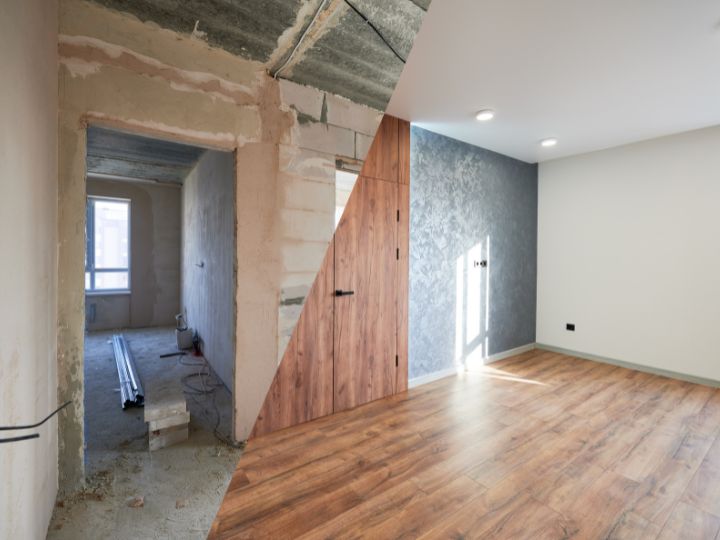
Eliminating Wasted Space: Reconfiguration Ideas for Awkward Phoenix Floor Plans

Phoenix homes, particularly ranch-style and older properties, often feature challenging floor plans with wasted space, awkward transitions, and disconnected rooms. Strategic reconfigurations can transform these problematic layouts into functional, flowing spaces that enhance both daily living and property value.
Phoenix's diverse architectural landscape includes everything from sprawling ranch homes to compact bungalows, many of which were built decades ago when space planning wasn't always optimized. Whether you're dealing with a 1950s ranch with a choppy layout, a historic bungalow with tiny rooms, or a Mediterranean-style home with awkward transitions, there are proven strategies to maximize every square foot.
Common Floor Plan Challenges in Phoenix Homes
The Ranch-Style Predicament
L-shaped and U-shaped layouts create dead zones. Ranch homes are often shaped like "L"s or "U"s with kinks and angles in the floor plan due to ongoing additions over time, leading to several problematic areas:
- Corner dead space where two wings meet
- Isolated rooms that feel disconnected from main living areas
- Inefficient hallways that consume valuable square footage
- Awkward traffic patterns that force you to walk through one room to reach another
Solutions for Ranch Layouts:
- Open up interior walls between the kitchen and living areas to create sight lines across the "L"
- Convert hallway space into useful storage with built-in cabinets or a home office nook
- Create a central gathering hub at the intersection of the L or U shape
- Add interior windows or pass-throughs to visually connect isolated rooms
Historic Home Space Challenges
Phoenix's historic districts contain beautiful homes with character, but they often feature compartmentalized layouts that feel cramped by today's standards.
Small, disconnected rooms were standard in earlier architectural styles, creating:
- Chopped-up living areas that feel cramped
- Inadequate storage throughout the home
- Poor natural light flow between rooms
- Wasted circulation space in narrow hallways
Historic Home Solutions:
- Selective wall removal to create more open concepts while preserving character
- Pocket doors to maintain flexibility between spaces
- Built-in storage solutions that don't require additional floor space
- Strategic lighting to brighten previously dark areas
Climate-Conscious Space Planning
In Arizona homes, kitchen configuration takes on added importance due to the climate, with considerations like refrigerator placement away from direct sunlight. This climate awareness should extend to overall space planning:
Heat management challenges:
- Rooms with excessive west-facing windows that overheat
- Poor ventilation in enclosed spaces
- Wasted potential for indoor-outdoor living connections
Climate-Smart Reconfigurations:
- Relocate heat-generating appliances away from main living areas
- Create cross-ventilation through strategic openings
- Maximize north-facing spaces for comfortable year-round use
- Design transition zones between indoor and outdoor areas
Room-by-Room Reconfiguration Strategies
Kitchen Reconfigurations
The kitchen is often the heart of awkward floor plan problems. Many Phoenix homes feature:
Galley kitchens that create bottlenecks Isolated kitchens cut off from living areas Insufficient counter space for entertaining
Kitchen Solutions:
- Remove the wall between kitchen and dining room to create an open concept
- Add a kitchen island or peninsula to increase workspace and create better flow
- Reconfigure the work triangle to improve efficiency
- Incorporate bar seating to connect the kitchen with adjacent rooms
Consider consulting resources on kitchen layout mistakes and kitchen renovation planning to avoid common pitfalls during your reconfiguration.
Living Area Optimization
Formal living rooms that go unused represent significant wasted space. These rooms, common in older Phoenix homes, can be repurposed as:
- Home offices with built-in desks and storage
- Libraries or reading nooks with floor-to-ceiling bookshelves
- Play areas for families with children
- Multi-purpose flex spaces that adapt to changing needs
Flow improvements:
- Remove or reduce interior walls to create sight lines
- Add interior windows to borrow light between rooms
- Create defined zones within larger spaces using furniture placement
- Install sliding barn doors for flexible room division
Bedroom and Bathroom Reconfigurations
Oversized bedrooms with poor layouts can be reconfigured to:
- Split into two smaller bedrooms for growing families
- Create an en-suite bathroom by borrowing space
- Add walk-in closets or dressing areas
- Include home office nooks or reading alcoves
Bathroom improvements:
- Combine small, separate bathrooms into one larger, more functional space
- Reconfigure bathroom layouts to eliminate wasted floor space
- Add storage through creative space planning
Converting Wasted Spaces into Functional Areas
Hallway Transformations
Wide hallways common in ranch homes can become:
- Built-in storage walls with cabinets and shelving
- Gallery spaces for artwork display
- Home office nooks with built-in desks
- Reading areas with window seats and built-ins
Underutilized Formal Spaces
Formal dining rooms that are rarely used can be converted to:
- Home offices with proper lighting and built-ins
- Craft rooms or hobby spaces with specialized storage
- Children's play areas with easy-to-clean surfaces
- Exercise rooms with mirrors and equipment storage
Awkward Nooks and Corners
Dead corner spaces can become:
- Reading nooks with built-in seating and lighting
- Storage solutions with custom cabinetry
- Display areas for collections or artwork
- Mini home offices with corner desks
Strategic Home Addition Considerations
Sometimes the best solution for an awkward floor plan involves adding space strategically. Home additions can solve multiple layout problems simultaneously:
Addition vs. Reconfiguration
When to add rather than reconfigure:
- Structural walls that can't be removed limit internal changes
- Overall square footage is insufficient for family needs
- Lot size and setbacks allow for expansion
- Budget considerations favor addition over extensive renovation
Strategic addition locations:
- Kitchen extensions to create better flow and functionality
- Master suite additions to separate private spaces
- Family room additions to create true gathering spaces
- Two-story additions for maximum space gain
Understanding the difference between home extensions and additions can help you choose the right approach for your specific situation.
Design Principles for Better Flow
Open Concept Benefits
Creating sight lines through your home makes spaces feel larger and more connected:
- Remove non-load-bearing walls strategically
- Use half-walls or columns to define spaces without blocking views
- Install transom windows above interior walls that must remain
- Create visual continuity with consistent flooring and color schemes
Zoning Within Open Spaces
Define functional areas without walls:
- Use furniture placement to create room boundaries
- Vary ceiling heights to distinguish different zones
- Change flooring materials to signal transitions
- Install different lighting for each functional area
Traffic Pattern Optimization
Improve circulation throughout your home:
- Create clear pathways that don't require walking through functional spaces
- Minimize direction changes in main circulation routes
- Provide multiple routes to key destinations when possible
- Keep pathways wide enough for comfortable passage
Maximizing Storage in Reconfigured Spaces
Built-In Solutions
Custom storage makes the most of awkward spaces:
- Floor-to-ceiling cabinets in former closets or alcoves
- Under-stair storage with pull-out drawers or shelving
- Window seat storage in bay windows or wide sills
- Corner storage solutions for typically wasted corner spaces
Multi-Functional Furniture
Pieces that serve double duty maximize functionality:
- Storage ottomans for seating and hidden storage
- Built-in banquettes with storage underneath
- Murphy beds for guest rooms that also serve as offices
- Fold-down desks that disappear when not in use
Budget-Conscious Reconfiguration Approaches
High-Impact, Low-Cost Changes
Maximum transformation for minimal investment:
- Paint and lighting changes to make spaces feel larger
- Strategic furniture removal to open up circulation
- Doorway widening to improve flow between rooms
- Interior window installation to borrow light
Phased Renovation Approach
Tackle projects incrementally:
- Start with cosmetic changes to visualize potential
- Remove non-structural elements like built-ins or partial walls
- Address electrical and plumbing as needed for new layouts
- Make structural changes when budget allows
For affordable home addition options and financing considerations, explore various budget-friendly approaches that can transform your space over time.
Working with Phoenix's Unique Architecture
Respecting Historical Character
Preserve what makes your home special:
- Maintain original architectural details like archways or exposed beams
- Work with existing room proportions rather than fighting them
- Keep characteristic features like built-in cabinets or window styles
- Update functionality while preserving character
Modern Updates for Classic Styles
Blend contemporary needs with traditional aesthetics:
- Add modern conveniences without compromising style
- Improve energy efficiency through strategic updates
- Enhance natural light while maintaining architectural integrity
- Create indoor-outdoor connections appropriate to your home's style
Professional Planning and Execution
When to Hire Professionals
Complex reconfigurations require expertise:
- Structural wall removal needs engineering analysis
- Electrical and plumbing changes require proper permitting
- HVAC modifications for new room layouts
- Building code compliance for all modifications
Design and Planning Phase
Proper planning prevents costly mistakes:
- Professional space planning to optimize layouts
- 3D renderings to visualize changes before construction
- Permit assistance for code compliance
- Timeline coordination for minimal disruption
Key to Successful Space Reconfiguration
Awkward floor plans don't have to be permanent features of your Phoenix home. Whether you're dealing with a sprawling ranch layout, a compartmentalized historic home, or any other challenging configuration, strategic reconfiguration can transform your space into a functional, flowing environment that works for your lifestyle.
The key to successful space reconfiguration lies in understanding your home's unique characteristics, identifying the specific problems you want to solve, and approaching changes strategically. Sometimes the solution involves removing walls to create open concepts, while other situations call for adding space or simply reorganizing existing rooms for better flow.
Ready to transform your awkward floor plan?
General contractors, The Contractor Guyz, understand the unique challenges of Phoenix homes and can help you develop a comprehensive plan that maximizes your space while respecting your home's character. From initial design consultation through final construction, their team specializes in turning problematic layouts into dream homes that work for real families.
Whether you're considering a simple reconfiguration or a more extensive renovation with additions, professional guidance ensures your project enhances both functionality and value. Contact Phoenix remodeling company The Contractor Guyz to explore how thoughtful space planning and expert execution can eliminate wasted space and create the flowing, functional home you've always wanted.
Latest Blogs
Transform your dream home into reality with our premier renovation services!
Book a call with us today and let's create the perfect space tailored just for you.

.svg)
.svg)



